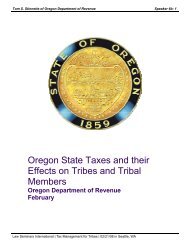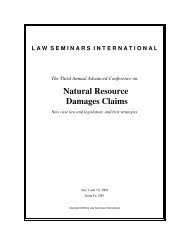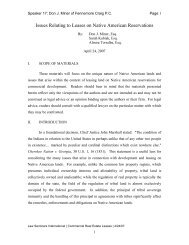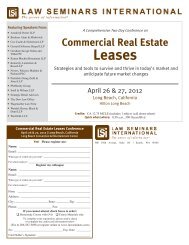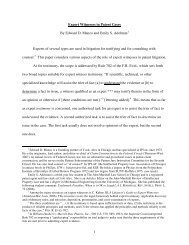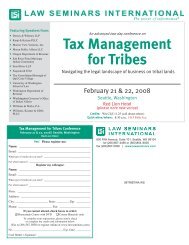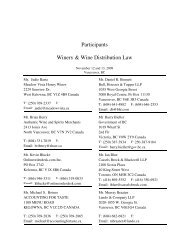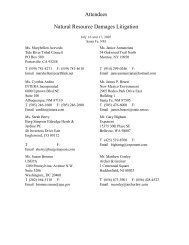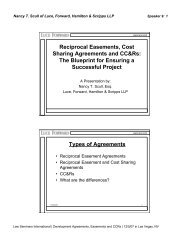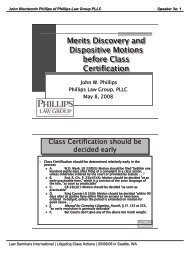LSI 2010 NRD Santa Fe final conference binder 072110.pdf
LSI 2010 NRD Santa Fe final conference binder 072110.pdf
LSI 2010 NRD Santa Fe final conference binder 072110.pdf
Create successful ePaper yourself
Turn your PDF publications into a flip-book with our unique Google optimized e-Paper software.
Allan Kanner of Kanner & Whiteley, L.L.C. Speaker 23: 9<br />
Through its police power a state may regulate the release of contaminants into the air, 20 protect<br />
the quality of water, 21 control land use through zoning regulations, 22 regulate storage and<br />
disposal of solid and hazardous substances, 23 and protect the public interest in wildlife. 24<br />
The public trust doctrine has its origins in ancient common law. 25<br />
During its early<br />
development in American jurisprudence, the doctrine was used to retain fisheries and land under<br />
interests. These “quasi-sovereign” interests include state interest in its general economy or environment, Late<br />
Corporation of the Church of Jesus Christ of Latter-Day Saints v. United States, 136 U.S. 1, 56 (1890); interstate<br />
water management, Wyoming v. Colorado, 286 U.S. 494, 509 (1932); pollution-free interstate waters, State of<br />
Missouri v. State of Illinois, 180 U.S. 208, 241, (1901); protection of the air and earth from interstate pollutants,<br />
State of Georgia v. Tennessee Copper Co., 206 U.S. at 238; and the general economy of the state, State of Georgia v.<br />
Pennsylvania Railroad Co., 324 U.S. 439, 447 (1945), reh’g denied, 324 U.S. 890 (1945).<br />
20 See, e.g., Northwestern Laundry v. City of Des Moines, 239 U.S. 486 (1916); Lees v. Bay Area Air Pollution<br />
Control District, 48 Cal. Rptr. 295, 299-300 (Cal. Ct. App. 1966)(holding that the regulation of air pollution is<br />
“essential and represents a lawful and proper exercise of the police power); State v. Burns, 591 P.2d 563 (Ariz. Ct.<br />
App. 1979); ARIZ. REV. STAT. § 49-401A (1987).<br />
21 See, e.g., Commonwealth of Pennsylvania v. Barnes and Tucker Company, 319 A.2d 871, 885 (Pa.<br />
1974)(“abatement of water pollution is unquestionably a reasonable exercise of the police power in the abstract”);<br />
Rochez Bros., Inc. v. Commonwealth of Pennsylvania, 334 A.2d 790, 796 (Pa. Commw. Ct. 1975); Morshead v.<br />
California Regional Water Quality Control Board, 119 Cal. Rptr. 586, 589 (Cal. Ct. App. 1975)(holding that<br />
“prevention of water pollution is a legitimate government objective in furtherance of which the police power may be<br />
exercised”).<br />
22 See, e.g., Johnson v. Village of Villa Park, 18 N.E.2d 887, 889 (Ill. 1938)(“Cities and villages have the right to<br />
adopt zoning ordinances as an exercise of their police power and thereby impose a reasonable restraint upon the use<br />
of private property.”); People v. Johnson, 277 P.2d 45, 49 (Cal. Ct. App. 1955)(“[z]oning is inherent in the police<br />
power”); Roselle v. Wright, 122 A.2d 506 (N.J. 1956).<br />
23 See, e.g., Meyers v. Town of Cornwall, 192 N.Y.S.2d 734, 738 (N.Y. 1959)(“a municipality may, in the exercise<br />
of its police power, adopt an ordinance which regulates the collection, storage or disposition of refuse and garbage”);<br />
Department of Transportation v. PSC Resources, Inc., 419 A.2d 1151 (N.J. Super. Ct. Law Div. 1980); State v. Byrd,<br />
708 So. 2d 401, 405 (La. 1998).<br />
24 People v. K. Sakai Co., 128 Cal. Rptr. 536, 539 (Cal. Ct. App. 1976); State v. Stewart, 253 S.E.2d 638, 639 (N.C.<br />
Ct. App. 1979)(“As the State’s wildlife population is a natural resource of the State held by it in trust for its citizens,<br />
the enactment of laws reasonably related to the protection of such wildlife constitutes a valid exercise of the police<br />
power vested in the General Assembly.”); Florida Game and Fresh Water Fish Commission v. Flotilla, Inc., 636 So.<br />
2d 761, 765 (Fla. Dist. Ct. App. 1994); COLO. REV. STAT. § 33-1-101(1) (1986 as amended)(“It is the policy of the<br />
state of Colorado that the wildlife and their environment are to be protected, preserved, enhanced, and managed for<br />
the use, benefit, and enjoyment of the people of this state and its visitors.” )<br />
25 See Kanner, supra note 8.<br />
© 7<br />
Law Seminars International | Natural Resource Damages | 07/16/10 in <strong>Santa</strong> <strong>Fe</strong>, NM




